
April 24, 2019 1:00 - 4:30
Energy and water resource management have historically been treated as separate concerns. However, water is used in the production of nearly every major California energy source as well as in our food system. Likewise, energy is used in multiple ways and at multiple steps in water delivery and treatment systems. According to the California Department of Water Resources, about 12 percent of the state’s total energy use is related to water (equal to 20 percent of electrical generation).
Risks imposed by climate change and interest in resilience have increased awareness of the interdependence of water and energy systems. At the national level, this heightened combined concern has been described in governmental studies and by the Pentagon as a matter of national security.
This half-day symposium featured speakers and participants from industry, academia, utilities, and government who jointly explored challenges and the path towards sustainable regions, cities, neighborhoods, and buildings. Topics included methods for sustainable water use and management, water-use intensity in electrical generation and cooling systems, and case studies in which water and energy have been considered in a holistic manner.
Location and Registration
PG&E Energy Center, 851 Howard St, San Francisco. This event was free and open to the public, and was also viewed by live webinar.
Speakers and Presentations
-

Heather Cooley, PhD
Director of Research at the Pacific Institute
Presentation: The Water-Energy Nexus
Heather Cooley conducts and oversees research on an array of water issues, such as sustainable water use and management, the connections between water and energy, and the impacts of climate change on water resources. She currently serves on the California Urban Stakeholder Committee and the California Urban Water Conservation Council’s Board of Directors. Her previous work includes studying climate and land use change and carbon cycling at Lawrence Berkeley Laboratory. She holds a BS in Molecular Environmental Biology and a Master’s degree in Energy and Resources from UC Berkeley.
-

Lyle Keck, PE
Building Performance Consultant at Affiliated Engineers
Presentation: Water-Energy Nexus: Holistic Solutions for Climate Change and Resiliency
Lyle Keck’s experience with engineering and performance analysis of building systems has led to the implementation of advanced heat recovery systems, radiant heating and cooling systems, and energy conserving operational strategies. He is also active in firm-wide initiatives including water stewardship, intelligent buildings, and high performance design. Lyle holds a BS Architectural Engineering from University of Colorado, Boulder.
-

Amelia Luna, PE, LEED AP, ENV SP
Project Manager at Sherwood Design Engineers
With more than nine years of civil and environmental engineering experience, Amelia Luna leads water reuse projects including wastewater treatment, net-zero and net-positive water systems, as well as water quality projects for urban planning and corporate campuses. Her expertise with onsite nonpotable water systems bolsters Sherwood’s integrated water management projects including those which fall under San Francisco’s Non-Potable Ordinance. Amelia earned her MS in Civil & Environmental Engineering from UC Davis, where she then led research and design criteria for Caltrans onsite water reuse pilot projects.
-

Prakash Rao, PhD
Research Scientist, Buildings and Industrial Applications at Lawrence Berkeley National Laboratory
Presentation: Resilient Water Supply and Demand
Prakash Rao conducts research and analysis into the potential for reducing the energy consumption and water use impacts of the US manufacturing sector while maintaining its productivity. His work also includes analysis of large-scale desalination, focusing on its energy implications and reduction opportunities. He received a doctorate in Mechanical and Aerospace Engineering from Rutgers University, and a BA in Mechanical Engineering from Carnegie Mellon University.
Continuing Education
This is approved for AIA Continuing Education 3.5 LUs/HSW.
Learning Objectives
- Participants will learn strategies for aligning conservation goals for water and energy, in order to make informed decisions regarding engineering, design and/or policy.
- Participants will gain understanding regarding the water intensity resulting from various electrical power generation methods, and of the energy intensity of various forms of municipal water sources.
- Participants will become familiar with methods for jointly estimating water and energy consumption, considering the ‘embodied water’ content of electrical power, based on commercial building case studies.
- Participants will gain understanding of sustainable water use and management, and impacts of climate change on water resources in California and beyond.
